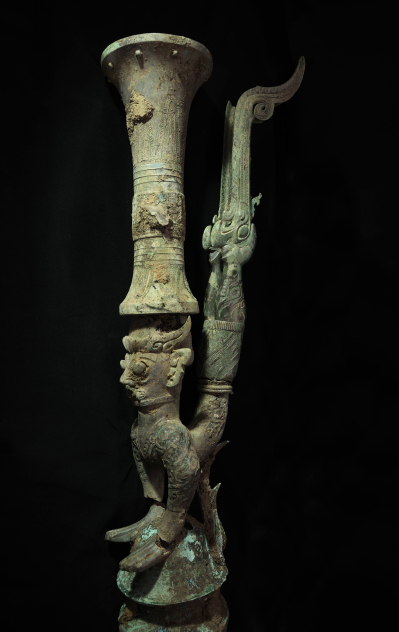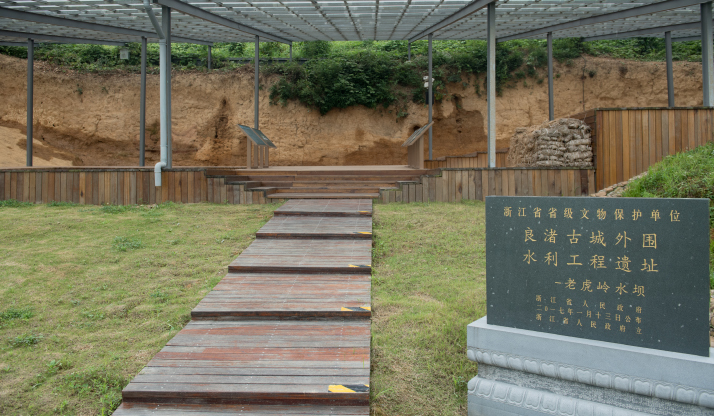| China |
| Archaeologists delve into the past, unraveling the mysteries of ancient Chinese civilization | |
|
|
 A bronze statue unearthed in June from the Sanxingdui Ruins in Sichuan Province has been united with a bird-footed part (upper right) excavated 36 years earlier (XINHUA)
Inside a conservation laboratory, the different parts of a bronze statue, after being roughly 3,000 years apart, were brought together in June to once again form a whole body. The parts had been excavated from Sichuan Province's Sanxingdui site, hailed as one of the greatest archaeological discoveries of the 20th century. Earlier that month, a large bronze figurine had been unearthed from the No.8 sacrificial pit of the Sanxingdui Ruins. It perfectly matched a bird-footed statue excavated 36 years earlier from the No.2 sacrificial pit. Fully assembled, the 1-meter-tall Y-shaped figure standing on its hands, as if striking a yoga pose, was an astonishing sight to behold. "Looking like an acrobat, its posture is so complex; I find it simply beyond imagination," said Ran Honglin, a leading archaeologist working on the Sanxingdui site. Located in the city of Guanghan, some 60 km from the provincial capital of Chengdu, the Sanxingdui Ruins are believed to be the remnants of the ancient Shu Kingdom, dating back at least 4,800 years. Chinese archaeologists have long been dedicated to the study of ancient kingdoms, including their artistic creativity expressed in large bronze castings and other artifacts, to verify the history of Chinese civilization—spanning 5,000 years.  The ruins of Liangzhu in Hangzhou, Zhejiang Province, on June 22, 2019 (XINHUA)
Fact or fiction China has long been believed to have five millennia of civilized history, yet until late last century, many academics were skeptical about, or even negated, the authenticity of the statement. So is this impressively long history myth or truth? Some historians believed that China's civilized history began with the first dynasty in Chinese history, the Xia Dynasty (roughly 2070-1600 B.C.), whereas others, doubting the very existence of Xia, held that ancient China became a civilized society from the late Shang Dynasty (1600-1046 B.C.), when metallurgy, plus a writing system and urbanization emerged. These three elements are common criteria for a civilization. If this is the case, Chinese civilization has a history of only 3,300 years. "However, not all of the world's major primitive civilizations have all these elements. For example, the Mayan civilization in Central America did not have metallurgy, the Inca civilization in South America did not have a writing system, and the patterns on the seals of the Harappan civilization in the Indus Valley were not recognized as 'writing.' So, the 'three elements' are not absolute standards," said Wang Wei, Director of the Academic Division of History under the Chinese Academy of Social Sciences. To trace the origins of the Chinese civilization, an investigation project got underway in 2002, carried out by members of nearly 70 research institutions and universities. The project came up with the criteria for verifying a civilized society: the development of production, population growth and the emergence of cities; the intensification of the social division of labor and differentiation, and the emergence of classes; plus, the continuous strengthening of power and the emergence of kingship and state. According to the research team, the earliest signs of a civilization in China emerged around 5,800 years ago in areas along the Yellow River, the middle and lower reaches of the Yangtze River, and the West Liaohe River in northeast China. Wang, who heads the project, said that years of large-scale excavations across ruins nationwide have provided proof of the existence of an at least 5,000-year-long Chinese civilization. For example, in the ruins of Liangzhu in the lower reaches of the Yangtze River, archaeologists uncovered an inner city with an area of nearly 3 million square meters and a larger outer city, dating back around 5,000 years. In 2015, China announced the discovery of a water project in Liangzhu including 11 dikes. The oldest large water system ever discovered in China to date, it is widely believed to have combined the functions of flood control, transportation and irrigation. In 2019, the UNESCO World Heritage Committee inscribed the Liangzhu Ruins on the World Heritage List as a cultural site. The organization's website says the ruins "reveal an early regional state with a unified belief system based on rice cultivation in Late Neolithic China," and they are "an outstanding example of early urban civilization expressed in earthen monuments, urban planning, a water conservation system and a social hierarchy expressed in differentiated burials in cemeteries within the property." "Liangzhu's ancient city is one of its kind in China," said Zhang Zhongpei, archaeologist and former curator of the Palace Museum in Beijing, adding it deserves to be called the first and foremost city of China. The Liangzhu Ruins allowed researchers to push back the inception of the Chinese civilization about 1,000 years earlier, before what has usually been recognized as the civilization's first flourishing with the Shang, or the proceeding Xia Dynasty, according to Colin Renfrew, an archaeologist and former professor of Archaeology at the University of Cambridge. Moreover, city ruins found at the Taosi and Shimao sites could date back roughly 4,000 years. Wang and other experts believe that social stratification is visible in the remnants of buildings and graves in these ancient cities. "These societies were most likely to have had the form of a state," Wang said. "We believe the region where these states were located had already entered the primary civilization phase." "The origin and early development of the Chinese civilization were not directly recorded in written form. Thankfully, we can now describe this historical period," Zhao Hui, another head of the project and a professor with the School of Archaeology and Museology at Peking University, said. "As the origins and early development of the Chinese civilization is an indispensable part of those of human civilization worldwide, it's safe to say our work has also filled in the blanks in global history," Zhao added. Passing on the legacy Wang has been working as an archaeologist for about four decades. His fascination with the beginning of Chinese civilization started in 1983, after reading The Origin of Chinese Civilization by Xia Nai (1910-85), a pioneering Chinese archaeologist who believed the formation of Chinese civilization began with the establishment of the Xia Dynasty. Wang and his team have persistently searched for the origins of civilization, pushing forward archaeological research domestically and worldwide. "Archaeology is a rising subject and the country is paying more and more attention; the public is getting more and more interested in archaeologists and their latest discoveries," Wang pointed out during a seminar at the Chengdu Museum in July. "Today, the equipment and level of our archaeological science and technology are on par with those of the world's developed countries, and the increasing interest from younger generations, too, can be a great asset." "Archaeological excavation can reproduce life and work scenes of the past. I was already very interested in history, and now I love the subject, and archaeology, even more," Tian Wanchen, a middle school student in Chengdu, said after hearing Wang's speech. "Maybe, at some point in the future, one passionate young archaeologist's discovery will rewrite history," Wang said. (Print Edition: Traces of Time) Copyedited by Elsbeth van Paridon Comments to luyan@cicgamericas.com |
|
||||||||||||||||||||||||||||||
|